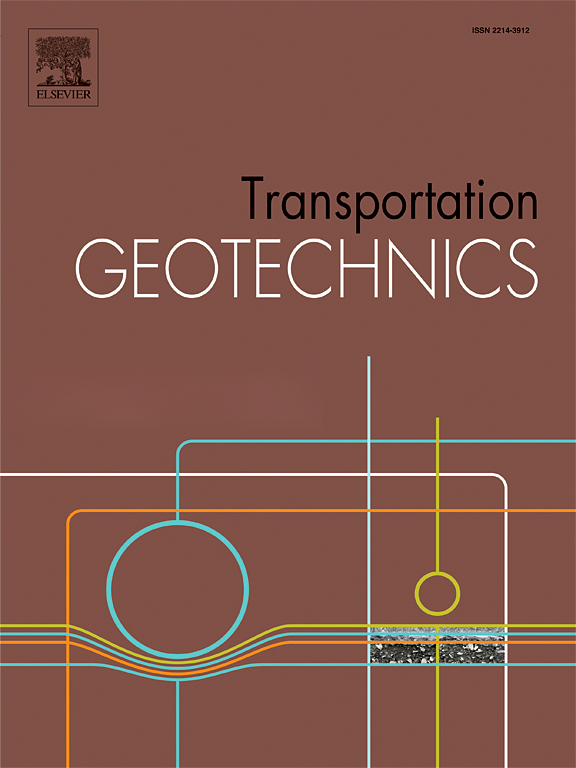Predicting the stress-strain behavior of gravels with a hybrid deep learning approach
IF 4.9
2区 工程技术
Q1 ENGINEERING, CIVIL
引用次数: 0
Abstract
Large-scale datasets and efficient model algorithms are crucial foundations in Machine Learning. The prediction ability of previous approaches in determining the stress–strain characteristics of gravels is hindered by small datasets and shallow Machine Learning methods with significant limitations in model generalization and feature extraction. With this consideration, a large-scale dataset for the stress–strain–volume change curves from triaxial compression test was established. This extensive collection includes 1039 records for 312 gravel types, along with stress–strain–volume change curves and 13 influence factors related to particle properties, soil mass properties, and test conditions. Subsequently, drawing inspiration from the success of hybrid Deep Learning models in sequence prediction tasks, such as air quality prediction, a novel Deep Learning model named Res-LSTM-PiNet was proposed through ablation studies. This model integrates the capabilities of the Residual Neural Network (ResNet) for deep feature extraction and Long Short-Term Memory (LSTM) for sequence feature learning, while also incorporating prior information constraints into the loss function. The results demonstrate that the proposed model effectively captures and predicts the mechanical behaviors of softening/hardening and shrinkage/dilatancy of gravels. Compared with the traditional LSTM model, the Mean Absolute Percentage Error of Res-LSTM-PiNet in predicting the stress–strain curve is significantly reduced from 28.2% to 14.3%. This study offers effective support for predicting the stress–strain–volume change curves of gravels in the absence of experimental data.
用混合深度学习方法预测砾石的应力-应变行为
大规模的数据集和高效的模型算法是机器学习的重要基础。以往的方法在确定砾石应力-应变特征方面的预测能力受到小数据集和浅机器学习方法的阻碍,并且在模型泛化和特征提取方面存在显着局限性。基于此,建立了大型三轴压缩试验应力-应变-体积变化曲线数据集。该数据包括312种砾石类型的1039条记录,应力-应变-体积变化曲线以及与颗粒特性、土体特性和试验条件相关的13个影响因素。随后,从混合深度学习模型在序列预测任务(如空气质量预测)中的成功中汲取灵感,通过消融研究提出了一种名为Res-LSTM-PiNet的新型深度学习模型。该模型集成了残差神经网络(ResNet)的深度特征提取和长短期记忆(LSTM)的序列特征学习功能,同时将先验信息约束纳入损失函数。结果表明,该模型能有效地捕捉和预测砾石的软化/硬化和收缩/膨胀力学行为。与传统LSTM模型相比,Res-LSTM-PiNet预测应力-应变曲线的平均绝对百分比误差从28.2%显著降低到14.3%。该研究为在缺乏实验数据的情况下预测砾石的应力-应变-体积变化曲线提供了有效支持。
本文章由计算机程序翻译,如有差异,请以英文原文为准。
求助全文
约1分钟内获得全文
求助全文
来源期刊

Transportation Geotechnics
Social Sciences-Transportation
CiteScore
8.10
自引率
11.30%
发文量
194
审稿时长
51 days
期刊介绍:
Transportation Geotechnics is a journal dedicated to publishing high-quality, theoretical, and applied papers that cover all facets of geotechnics for transportation infrastructure such as roads, highways, railways, underground railways, airfields, and waterways. The journal places a special emphasis on case studies that present original work relevant to the sustainable construction of transportation infrastructure. The scope of topics it addresses includes the geotechnical properties of geomaterials for sustainable and rational design and construction, the behavior of compacted and stabilized geomaterials, the use of geosynthetics and reinforcement in constructed layers and interlayers, ground improvement and slope stability for transportation infrastructures, compaction technology and management, maintenance technology, the impact of climate, embankments for highways and high-speed trains, transition zones, dredging, underwater geotechnics for infrastructure purposes, and the modeling of multi-layered structures and supporting ground under dynamic and repeated loads.
 求助内容:
求助内容: 应助结果提醒方式:
应助结果提醒方式:


